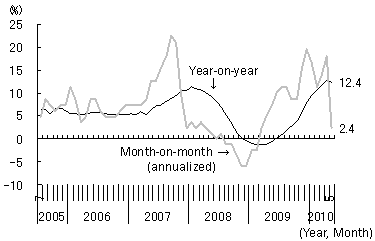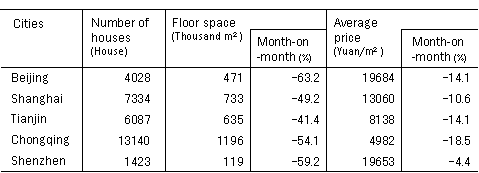The real estate market in China has shown signs of an asset bubble, following the easy monetary policy adopted after the collapse of Lehman Brothers, with housing prices in major cities surging at a pace of over 10% on a year-on-year basis ( figure 1 ). As a result, public discontent is growing, as the dream of buying a house becomes more and more remote. If the real estate bubble continues to expand, the impact on the banking sector and the macro economy when it finally bursts will be that much bigger. To avoid this situation, the State Council issued a Circular on Firmly Restraining Housing Prices from Too Rapid Rising in Certain Cities (Circular 10) on April 17, 2010. Following this move, the real estate market is now entering a correction phase.
Figure1 : China's Real Estate Market Bubble
- Housing prices of 70 large and medium cities -

(Source) National Bureau of Statistics of China
Measures to deal with the real estate bubble firmly in place
The Circular contains the following measures in areas ranging from bank lending to real estate taxes and the supply of houses, showing the government's strong determination to deal with the real estate bubble.
First, a strictly differentiated mortgage loan policy will be adopted, taking the floor space of a property and the buyer's intended use into account. More specifically, first home buyers, who purchase a residential house with a floor space of 90 square meters or more, must have a down payment of at least 30%. When purchasing a second house, the down payment must be 50% or more, and the lending interest rate must be at least 1.1 times the base rate. If a buyer purchases three or more houses, commercial banks must raise the down payment ratio and the lending interest rate significantly, according to the risk management principle.
In addition, in an effort to strictly rein in real estate speculation, even more stringent measures will be required in regions where the real estate market is seriously overheated. These measures include the termination of mortgage loans for the purchase of a third house, the temporary suspension of new mortgage loans to non-local residents, and the limitation on the number of houses a single family can buy within a certain period of time. In fact, these measures have already been adopted in Beijing and a number of other major cities.
In terms of taxes, a property holding tax for the ownership of houses should be put in place, and a land appreciation tax (capital gains tax) should be levied rigorously under the tax law.
Finally, the effective supply of houses will be increased. In cities where housing prices have risen too quickly, there are plans to substantially increase the supply of residential land sites, public rental housing, and development projects with small and medium sized-regular homes.
Policy effects becoming apparent
After a period of rising prices, the real estate market is now entering a correction phase, as these measures begin to take effect. According to the National Bureau of Statistics of China, the month-on-month rise in housing prices in 70 large and medium cities slowed from 1.4% (18.16% on an annualized basis) in April 2010 to 0.2% (2.4% annualized) in May. According to data from the China Index Research Institute, which appear to reflect the market situation more accurately, the total floor space sold in 30 major cities was down 44.2% from the previous month in May 2010, and the decline was even larger than average in major cities such as Beijing, Shanghai, Tianjin, and Chongqing, where investment real estate was believed to be most overheated. And in general, housing prices fell in major cities during May, with the fall exceeding 10% on a month-on-month basis in Beijing, Shanghai, Tianjin, and Chongqing ( table 1 ).
Table1 : Sales and Prices of Housing in Major Cities (May 2010)

(Source) China Index Research Institute
The fact that the decline in the total floor space sold is larger than the drop in selling prices of houses indicates that purchasers are reluctant to buy, anticipating a further fall in prices, while sellers are holding out in hope of higher prices. However, sellers are likely to be forced to cut prices at some stage, as their cash position deteriorates. Thus the sharp decline in the total floor space sold suggests that real estate prices are likely to fall further in the months ahead.
This turnaround in the real estate market has put further downward pressure on stock prices in China, which have already fallen sharply thanks to the serious stock market correction seen in major markets around the world and concerns about monetary policy tightening. The performance of not only real estate stocks but also bank stocks has been weak over fears of a contracting mortgage loan market and an increase in bad debt.
Differences between China now and Japan before and after the bubble
Although there is a concern that China may see the same kind of serious downturn that Japan experienced in the 1990s if real estate prices fall too far, the possibility looks remote, for the following reasons.
First, while Japan in the late 1990s was already a mature developed nation, China is still a developing country with high growth potential. In fact, while the post-bubble growth rate in Japan seldom went beyond 2-3% and sometimes turned negative during recessions, the growth rate in China has been as high as 12-13% during the boom periods and 7-8% even during downturns. Rising income associated with high growth underpins real estate prices and helps households to repair their balance sheets in case they were damaged by large falls in real estate prices.
In addition, the financial dependency of real estate transactions on banks is relatively low in China, compared to Japan during the bubble period. During Japan's bubble heyday in the 1980s, bank lending to the three real estate-related industries of construction, real estate, and non-banks accounted for 25% of all bank loans, even excluding mortgage loans. In particular, a large portion of property-related loans were provided through non-banks such as the Jusen companies (mortgage lenders) that were outside the supervision of the regulatory authorities, and this intensified the ballooning of the real estate bubble and aggravated the impaired loan problem after the bubble burst. In contrast, real estate-related loans made up only 20% of all bank loans, even including mortgage loans (7% excluding mortgage loans) as of March 2010 in China.
However, statistics on real estate-related loans could underestimate the true circumstances, as they do not include loans that flow into the real estate market through financing platforms established by local governments. Nevertheless, the result of stress tests conducted on major banks by the China Banking Regulatory Committee (CBRC) in light of this shortcoming has discovered that as long as the fall in housing prices is 30% or less, the impact on banks will be limited. More specifically, it was found that if housing prices fall 30%, the ratio of non-performing loans will rise from 1.04% to 1.41% and the expected losses will be equivalent to 8% of pretax profits at nine major banks in Shanghai.
Although a decline real estate prices is inevitable given the policies adopted by the Chinese government, the possibility of a soft landing is still high and excessive pessimism appears unwarranted.


